Different Types of Textile Raw Materials and Their Brief Details
Textile Raw Materials
Raw material has been defined as material that has not been subjected to a specific process of manufacture. Textile raw materials are materials that can be converted into yarns and fabrics of any nature and character. Fiber is a raw material used in textile manufacturing.
Textile:
The word "Textile" originates from the Latin word "Texture" which means to weave. But as the Textile Institute's terms and definition " Textile is a general term applied to any manufacturing from fibers, filaments or yarns characterize by flexibility, fineness and high ratio of length to thickness.
Fiber:
A fiber is a material that is several hundred times as long as it is thick.
Textile Fibre:
Textile Fibres are materials of natural or artificial origin that can be converted into yarn and fabric for clothing and also for domestic and industrial purposes by interlacing or interloping.
The essential requirements for fibres are
- Length should be a thousand times higher than its width
- Cohesiveness
- Sufficient strength
- Elasticity
- Fineness
- Uniformity
- Durability
- Luster
Process Sequence of Textile:
- Fibre
- Yarn
- Grey Fabric
- Finished Fabric
- Garments
Types of Textile Fiber:
Generally two types of fiber.
1. Natural fiber.
2. Manmade fiber.
Natural Fiber:
Natural fibers include those produced by plants, animals, and geological processes. They are biodegradable over time. They can be classified according to their origin.
Manmade Fiber:
It is also known as Manufactured fiber Synthetic or man-made fibers mainly come from synthetic materials but some types of synthetic fibers are manufactured from natural cellulose, for example, rayon
Difference between Natural fiber and Manmade fiber
Natural fibre Manmade fibre
1. Dust and impurities could be found in natural fiber 1. No dust and impurities are found in Manmade fiber
2. It is not possible to change fiber structure 2. It is easy to change the fiber structure
3. It is environment friendly 3. Some manmade fibers are harmful to the environment. e.g Polypropylene
4. It is costly 4. It is cheaper than natural fiber
5. Fabric made of natural fiber is comfortable. 5. Fabric made of manmade fiber is not comfortable and hygienic
6. It cannot grow everywhere. We have to depend on 6. For production manmade need to produce.
nature
› Classifications of Textile Fibre:
1. Classification according to their nature and origin
2. Classification according to botanical zoological or chemical
3. Classification according to the ability to attack water
4. Classification according to Thermo plasticity
5. Classification according to Their utility
6. Classification according to Length.
Classification according to their nature and origin:
Fibre-
i) Natural Fibre
1. Vegetable Fiber
Leaf/Vascular/(i.e.: Pineapple, Sical) Seed Fibre. Le: Cotton, Kapok) Bast Fibre, (ie: Jute, Flux)
2. Animal Fibre
Silk Hair(Horse, Camel)
3. Mineral(Asbestos)
ii) Manmade Fibre
1. Regenerated (Viscose Rayon, Acetate, Tri Acetate)
2. Synthetic (Nylon, Polyester) 3. Inorganic (Glass, Carbon)
Classification according to botanical or zoological or chemical:
1. Vegetable
Fibre-
Leaf/Vascular, (L.e.: Pineapple, Sisal) Seed Fibre, (i.e.: Cotton, Kapok) Bast Fibre, (.e.: Jute, Flux)
2. Animal Fibre
Wool(Sheep) Silk
Hair(Horse, Camel)
3. Mineral (Asbestos)
Classification according to the ability to attack water:
Fibre-
i) Hydrophilic (i.e.: Cotton, Jute) 1) Hydrophobic (e.g.: Polyester, Polyethene)
▸ Classification according to Thermo plasticity:
> Fibre-
1) Thermo plastic ii) Non Thermo plastic
› Classification according to Their utility:
Fibre-
i) Major Textile Fibre
ii) Minor Textile Fibre
Classification according to Length:
› Fibre-
i) Staple fiber
ii) Filament fiber
› Properties of Textile fiber:
1. Physical properties:
✓ Length
✓ Fineness
✓ Crimp Maturity
✓ Lusture
✓ Softness
✓ Resiliency
✓ Work of rupture
✓ Elongation
✓ Density Appearance
✓ Flexibility
✓ Toughness
2. Mechanical properties of Fiber:
✓ Strength
✓ Elasticity
✓ Extensibility
✓ Rigidity
3. Chemical properties of Fiber:
✓ Solubility in aqueous salt
✓ Solubility in organic salt
All fibers are not Textile fibers:
All the fibers can not be Textile fibers because to be textile fiber it should possess some important qualities. It should have sufficient strength, length, fineness, elasticity, crimp, and friction power to protect the effect of biological agents, etc. It should be available to cotton, jute, etc. are textile fibers as they have the above qualities but fibers of the banana tree only fibres and not textile fibre as they do not pose quality like strength, elasticity, appearance etc. So, we can say all fibers are not textile fibers.
▸ Filament:
The word filament is the form of the Latin word filum, which means "thread". It is a very fine thread or thread-like structure which is a single fibril of natural or synthetic textile fiber of identical length, sometimes several miles long.
Difference between Fiber and Filament
Fibre Ordinary Filament
1. They are formed by polymerization 1. They are not so formed
2. They have large molecular weight 2. They have small molecular weight
3. Molecules are formed by H-bond, Vanderwall 3. Molecules are formed by electrovalent or covalent forces
4. Fibers are mainly shorter in length 4. Fibers are continuous in length
Cotton: The seed hair of a wide variety pplantsof the Gossypium family is called Cotton.
› Botanical Name of Cotton:
✓ Gossypium Harbaceum
✓ Gossypium Arboretum
✓ Gossypium Hirsutum
✓ Gossypium Barbadense
Chemical composition of Cotton:
Chemical Amount(%)
Cellulose 94
Protien 1.3
Pectin 1.2
Ash 1.2
Wax 0.6
Total Sugar 0.3
Pigment Less
Others 1.4
Total 100
Lint: primarily obtained fibers after separating from seeds
Linters: After separating lint, some short fibers are found which are called lintels
Types of commercial cotton
Name Description
1. Sea Island cotton This is the highest quality and most valuable cotton. It grows on the coast of Florida, Barbados, etc. Staple length of fibres is 2
2 Egyptian cotton It is of two types, one is brown and the other is white. Staple length of fibres is 1.5-1.75"
3 South American Cotton Staple length of fibres is 1-1.5"
4. American Cotton It is cultivated in the United States. The staple length of fibers is 0.9"-1 25"
5. Indian cotton is not suitable for spinning coarser counts. Staple length of fibres is 0.6-0.8
6. China cotton has the lowest grade. It is used to mix with better qualities. Staple length is 0.5-0.7"
Classification of cotton concerning the staple length:
1. Long staple: Top-quality cotton. Staple length 1-2.5"
2. Medium staple: Medium strength. Staple length 0.5-1.3
3. Short staple: Low-graded cotton. Staple length is 0.4"-1""
Classification of cotton fiber according to maturity:
1. Mature fiber: Well-developed secondary cell wall and very small lumen.
2. Immature fiber: Fibres with a thinner secondary cell wall and larger lumen.
3. Dead dibre: They have only primary cell walls. They remain undyed in dyeing.
Cotton fiber strength Increases after wetting
When water molecules penetrate into the interior of fiber, they lie between the fibril of the fiber where they can easily form Hydrogen bonds with free Hydroxyl groups of cellulose. The water absorption causes the swelling of the fiber. Absorbed water cements the cellulosic chains with fibrils. So the strength of cotton fiber increases after wetting.
Bangladeshi cotton:
Commercially hybrid cotton is produced in Meherpur, Jessore, Kustia and Gazipur. The quality of
Bangladeshi cotton is improving now. Length, color, and maturity are also very good.
Chemical properties of cotton fiber:
-Molecular structure: Cellulosic
-Effects of bleach: Hydrogen Peroxide bleach is used as a bleaching agent.
-Effects of acids and alkalis: Dissolved in highly concentrated HCl, H2SO4. Resistant to alkalis. So strong NaOH is used for cotton mercerizing.
-Effect of heat: Cotton has excellent heat resistance.
-Effect of sunlight: There is a gradual loss of strength when cotton is exposed to sunlight and the fiber turns to yellow.
-Dye ability: Direct, reactive, and vat dye.
Faults of cotton fiber:
Neps: groups of entangled fibres, which form at cotton processing. In spinning, neps are eliminated by combing. Trash: Except fiber other impurities such as dust, broken seeds, broken leaves, etc. are called trash. Dust: They are particles between 50-500 micrometers.
Uses of Cotton Fiber:
Cotton fiber is a versatile fiber that has a wide variety of uses.
Cotton fiber is mostly used in the Apparel Industry to make the wearing cloth like Sweaters, Skirts, Shirts, Swimwear, Kids' wear, Blouses, Pants, and Hosiery, and to make other types of dresses. The absorbency of cotton makes it an excellent material for mats and towels.
Physical composition of Cotton:
✓ Length: "-2½"
✓ Strength: 3-5 gm/Denier
✓ Density (gm/cc): Less than both silk & wool but more than linen
✓ Elasticity: 1.40-1.58
✓ Resiliency: low
✓ Abrasion Resistance: Medium
✓ Color: Yellowish or Cream, like clean white
✓ Heat preventive power: Medium
✓ Specific gravity: 1.52-1.55
✓ Stiffness:57-60 g/d
✓ Dimensional Stability: Medium
Faults of Cotton:
1. Damp Cotton
2. Immature fibre
3. Dead fibre
4. Cake formation 5. False mildew
6. Cellulose degradation.
7. Paste formation
8. Cotton Rust
9. Powdery mildew
10. Lint root
11. Sticky cotton
Structure view of Cotton Fibre/ Micro Structure of Cotton Fibre:
 |
| Structure view of Cotton Fibre |
Primary cell wall
Inside the cuticle, the primary cell wall is composed mainly of cellulose in which the fibrils are arranged.
Secondary cell wall
Under the primary cell wall, there is a secondary wall which consists of fibrils. The secondary cell wall has several layers.
Lumen
The hollow central core of the cotton fiber is known as the lumen.
Chemical Structure of Cotton:
Cultivation of Cotton fiber:
Cotton is a warm-weather plant, cultivated in both hemispheres mostly in the northern hemispheres. The cotton plant is a tree or shrub that grows naturally as a perennial, but for commercial purposes, it is grown as an annual crop.
Planting time varies with locality i.e. from February to June in the northern hemispheres. The planting time in the northern hemisphere is the harvesting time in the southern hemisphere.
Cotton seed is usually sown in spring. Seeding emerges from the soil within a week or two weeks after planting.
Color of cotton:
Color is one of the most important properties of cotton. It is strongly connected with the conditions of cotton cultivation as well as with fiber quality Color is a basic criterion that decides the quality classification of cotton raw materials.
The color of the fibers is affected by climatic conditions, the impact of insects and fungi, the type of soil, storage conditions, etc. Pence of Determination of Color of Cotton:
(parameters).
Reflectance whiteness of light-
The color of cotton samples is determined from two parameters: degree of reflectance (Rd) and yellowness (+b). As the color of cotton deteriorates, the processability of the fibers decreases.
HVI (High Volume Instrument) is used to determine the color of cotton samples HVI measures:
reflectance (Rd) - the whiteness of the light that is reflected by the cotton fibers,
yellowness (+b)- the yellowness of the light that is reflected by the cotton
fibers.
Except for fiber other impurities such as dust, broken seeds, broken leaves, etc. are called trash.
Cotton Fiber Grading Grading of cotton fiber is done by measuring the staple length, fineness, strength, color, and trash content of fiber.
(the average length of a group of fibers)
Grading of American Cotton
Middling fair
Strict good Middling Good Middling
Strict Middling Middling
Strict love Middling Low Middling
Strict good ordinary
good ordinary
Grading of Egyptian Cotton
Extra fine
Fine
Good Fully Good Fair
Good Fair
Fair
Cotton Ginning:
Cotton gin A cotton gin is a machine that quickly and easily separates cotton fibers from their seeds, allowing for much greater productivity than manual cotton separation
Ginning is of two types-
1) Saw gin 2) Roller gin
1. Saw Gin
The disc number of saw gin is 10-100 and the production capacity is 100-1000 kar
Cotton Ginning Procedure:
-The cotton with seed is fed by a feed table or airflow.
-Spiked roller throws the cotton with seed on the grid bar.
-Discs of saw gin permit the entry of seed-free fiber through the hole of the bar. -The empty path of bars permits the entry of fibers but not seeds.
-Separated seeds fall on the conveyor.
-The cotton lights are separated from saw teeth by proper airflow.
(Lint primarily obtained fibers after separating from seeds)
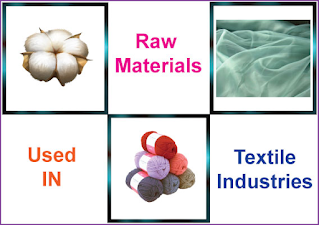
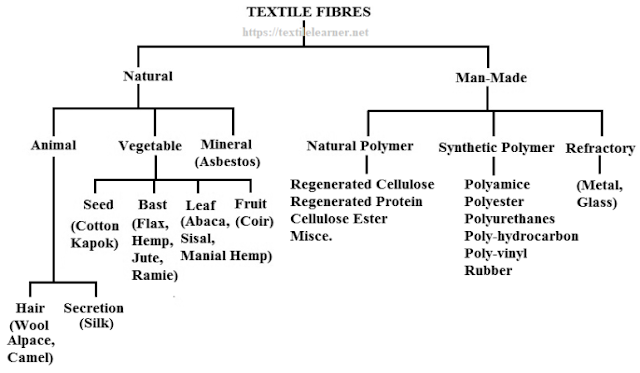
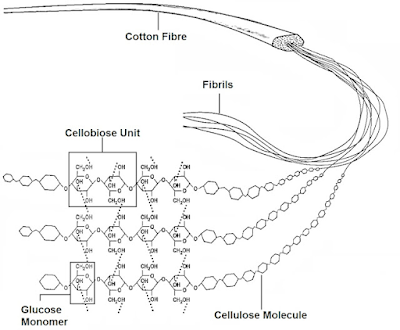
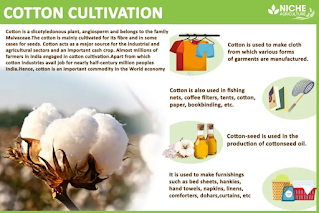
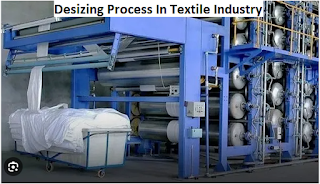


Comments
Post a Comment